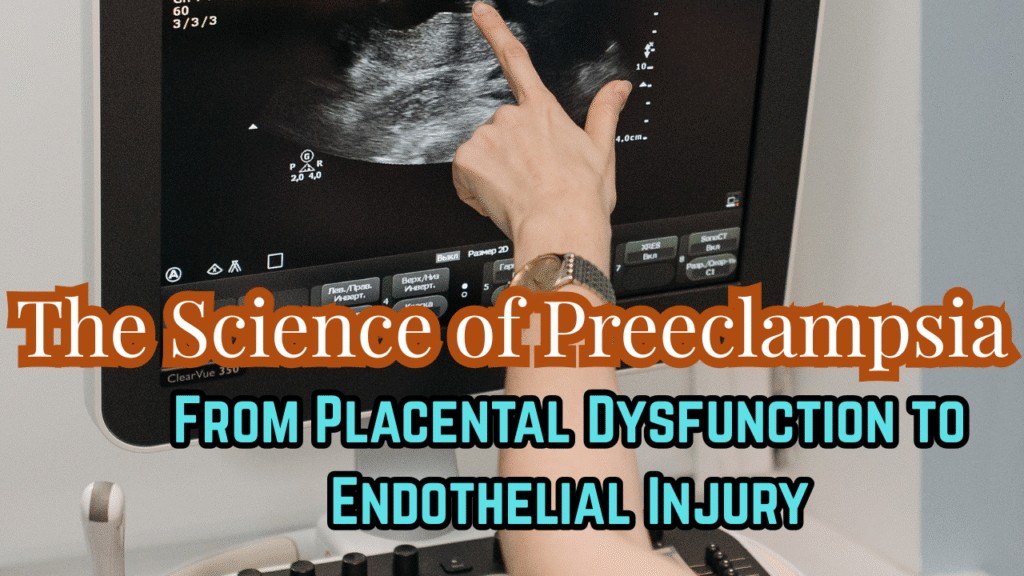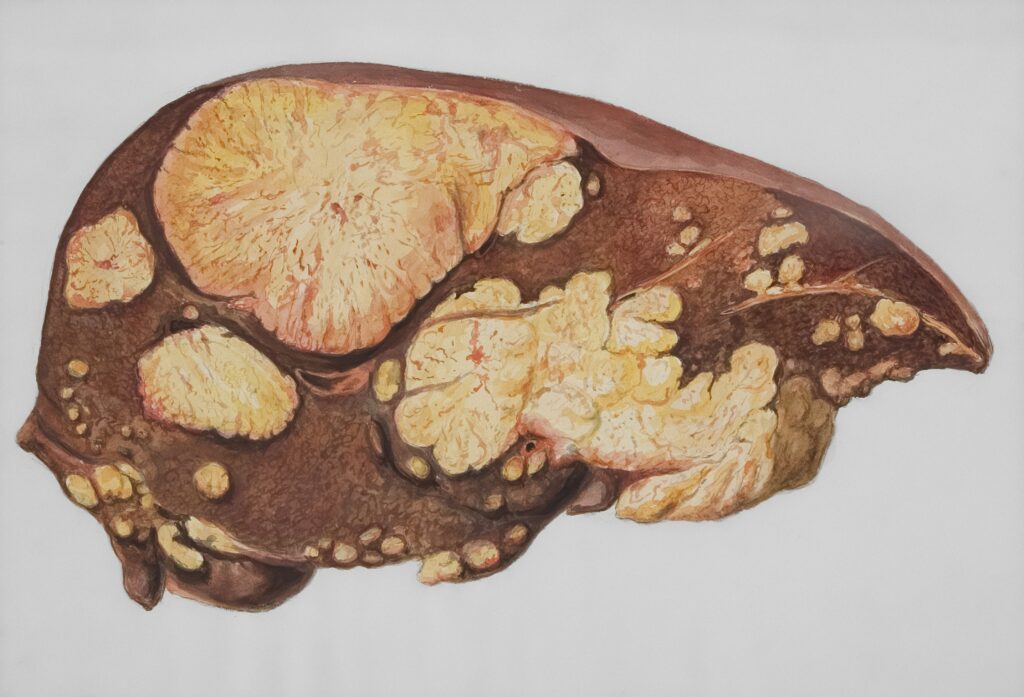
Table of Content:
- Definition of Preeclampsia
- Sign and symptoms of Preeclampsia
- Difference between Gestational hypertension and Preeclampsia
- Complications of Preeclampsia
- Diagnosis
- Risk factors
- Pathogenesis of Preeclampsia
- Relationship b/w Preeclampsia and Intrauterine growth restriction (IUGR)
- Role of Nitric oxide in Preeclampsia
- Prevention of Preeclampsia
- Management of Preeclampsia
- Key Takeaways
- References

Preeclampsia:
Preeclampsia, formerly called as “toxemia of pregnancy” is defined as high blood pressure in pregnancy after the gestational age of 20 weeks associated with the following conditions:
- proteinuria (>300 mg/day or 0.3g/day)
- multiple organ dysfunctions in severe cases e.g. Renal, hepatic, neurological, and haematological abnormalities
- Uteroplacental dysfunction potentially causing intrauterine growth restriction (IUGR) and damage to the liver and kidneys or fluid to build up in baby’s lungs.
- Sign & Symptoms of Pre-eclampsia:
The 3 main early signs of preeclampsia usually include:
- High blood pressure.
- Retaining water or swelling, this can cause weight gain of the patient
- Protein in your pee.
In preeclampsia, structural damage to the kidney filter (especially podocyte dysfunction and Glomerular basement membrane damage) lets proteins leak, even though filtration is reduced overall in sever case with very little urine production.
Other symptoms that also develop during preeclampsia are as follow:
- Headaches.
- Blurry vision or light sensitivity.
- Dark spots appearing in your vision.
- Abdominal pain especially on Upper right side of abdomen.
- Swelling in your hands, ankles and face (edema).
- Shortness of breath i.e. dyspnea.
Signs of Severe pre-eclampsia:
Blood pressure reaching to 160/110 mmHg or higher can aggravate the symptoms of preeclampsia and resulting affect body’s organs drastically leading to the complication like HELLP syndrome (hemolysis, elevated liver enzymes and low platelet count i.e. platelets less than 100 × 109/L.) and other conditions including:
- Decrease in kidney.
- Pulmonary edema: Fluid build-up in your lungs due to inflammation of endothelium and resulting leakage of fluid.
- Not producing or producing very little pee due to glomerular endotheliosis.
- High creatinine level
Do you know the difference between gestational hypertension and preeclampsia?
Complication to mother:
If preeclampsia is left untreated it can cause serious life-threatening conditions like:
- Seizure
- Eclampsia
- Coma
- Stroke
- Developing preeclampsia in future pregnancies.
Complication to fetus:
Most commonly observed complication in the fetus includes:
- Premature birth, highly observed in babies born to a mother suffering from preeclampsia.
- Low birth weight.
- Placental abruption.
- Neutropenia and thrombocytopenia
- Intra-uterine growth restriction (IUGR)
Diagnosis:
As a routine checkup the physician will check the blood pressure of the patient from which she can came to know or suspects the preeclampsia, on suspicion, the physician might recommend further tests for the confirmation of the preeclampsia, that might include:
Risk Factors:
Risk factors of preeclampsia are of different nature like demographic, dietary, environmental, genetic, and disease associated. Which are defined as follow:
- Dietary Risk Factors:
High total energy & dietary salt intake or lower magnesium and calcium during pregnancy have been associated with the HTN-Preg. Other studies have unveil a linkage between reduced serum levels of magnesium, calcium, vitamin D, and zinc and preeclampsia.
- Environmental Risk Factors:
Exposure to environmental contaminants, fine particulate matter, & nitrogen dioxide may also augment the risk of preeclampsia.
- Diseases Risk Factors:
If the patient is already suffering from any medical and psychological conditions, including heart disease, chronic respiratory disorders, diabetes, kidney disease, systemic lupus erythematosus, reproductive tract surgery, history of antepartum hemorrhage, and mental stress, then the risk of preeclampsia in such patient increases upon getting pregnant.
The role of genetic, demographic, dietary, and environmental factors in predisposing to defective placentation and PE (Preeclampsia) could vary in different geographical and world regions and needs to be thoroughly examined.
The risk factors are also classified on the basis of level of risk, into high and moderate risk factors of preeclampsia.
Pathogenesis:
Although preeclampsia is a major cause of maternal and fetal morbidity and mortality, its etiology and pathophysiology are not fully understood. Certain genetic, demographic, dietary, and environmental risk factors are believed to cause abnormal expression of uteroplacental integrins, cytokines and matrix metalloproteinases, leading to a common mechanism in all, expressed as, decreased maternal tolerance, apoptosis of invasive trophoblast cells, and inadequate spiral arteries remodeling (the most prominent one) resulting in reduced uterine perfusion pressure (RUPP), and placental ischemia/hypoxia.
“Inadequate placentation and trophoblast invasion of the spiral arteries and uterine wall, result in placental ischemia/hypoxia”.
The overall development of preeclampsia symptoms is thought to be consists of 2 phases: Abnormal placentation phase and endothelial dysfunction phase. These phases are explained as follow:
Phase-1: Mechanisms of abnormal placentation in preeclampsia.
(1) Early in pregnancy, trophoblast cells invade the maternal decidua to establish a connection between maternal blood supply and the developing fetus.
(2) In a healthy pregnancy, extra villous trophoblasts invade the maternal spiral arteries, transforming these high-resistance vessels into low-resistance channels, in order to provide adequate blood flow to the placenta and fetus. But in preeclampsia, the invasion of trophoblasts is shallow, failing to reach the deeper segments of the spiral arteries. This leads to increased resistance and reduced blood flow to the placenta.
(3) A balanced immune response is essential. Dysfunctional interactions between immune cells and trophoblasts in preeclampsia lead to inadequate spiral artery remodeling.
Mechanism:
There is basically two-way mechanism involved in immune balance:
- Cytotrophoblasts and Maternal Natural Killer Cells (Immune Evasion/Protection Mechanism)
- Uterine NK (uNK) Cells and Trophoblasts (Spiral Artery Remodeling Mechanism)
- Cytotrophoblasts and Maternal NK Cells (Immune Evasion/Protection Mechanism)
- Cytotrophoblasts (specifically extra villous trophoblasts, EVTs) express non-classical MHC class I molecules: HLA-C, HLA-E, and HLA-G
- These molecules bind to inhibitory receptors on maternal immune cells, especially uterine natural killer (uNK) cells: KIRs, CD94/NKG2A, ILT2
Purpose: This interaction inhibits cytotoxic activity of NK cells, helping the fetus avoid immune rejection — because the fetus expresses paternal antigens, it’s “semi-foreign” to the mother.
In preeclampsia, a decrease in HLA-C/KIR interaction would lead to increased activity of NK cells and attack of placental and fetal tissues.
Also, whereas healthy pregnancy is associated with moderate activation of the complement system, HTN-Preg is associated with an increase in the complement activation products Bb, C3a, and C5a.
- Uterine NK (uNK) Cells and Trophoblasts (Spiral Artery Remodeling Mechanism)
- uNK cells, which are abundant in the decidua (maternal uterine lining, Decidual NK cells (dNK) are a special subset — they are not cytotoxic like peripheral NK cells.), interact with trophoblasts to:
- Promote trophoblast invasion
- Facilitate spiral artery remodeling
- These interactions are pro-tolerant and growth-promoting, through:
- Secretion of VEGF (Vascular Endothelial Growth Factor), PlGF (Placental Growth Factor), IL-8, and MMPs (Matrix Metalloproteinases)
- Regulated by KIR–HLA-C/G binding
Purpose: This promotes adequate blood flow to the placenta, supporting fetal growth and preventing disorders like preeclampsia and IUGR.
In PE, these immune interactions are often dysfunctional. Uterine NK cells may fail to recognize and support trophoblast invasion effectively, leading to inadequate spiral artery remodeling.
Changes in uteroplacental remodeling and placental vascularization decrease placental blood flow and lead to IUGR
(4) The inadequate remodeling creates a hypoxic and ischemic environment within the placenta, stimulating the release of pro-inflammatory cytokines e.g. TNF-a & IL-6, anti-angiogenic factors and other bioactive molecules. And as the spiral artery doesn’t acquire its special morphology, by conversion from a state of artery to a loose vascular channel by cytotrophoblasts for the copious supply of blood to the fetus so, the pressure of the blood coming from the mother can also damage this artery leading to its inflammation and sometimes even get rupture along with bleeding resulting in placental abruption.
(5) These bioactive molecules are carried via excess of SDEVs (Syncytiotrophoblast-Derived Extracellular Vesicles, small membrane-bound particles released from syncytiotrophoblasts (a layer of the placenta) into the maternal circulation.) into maternal circulation that induce inflammation, endothelial dysfunction, and coagulation abnormalities, which leads to exacerbation of systemic endothelial dysfunction in mother.

Dysfunctional spiral artery remodeling (James, Harris, & Wareing, 2024)
Phase-2: Systemic Endothelial Dysfunction:
Studies in animal models of HTN-Preg have suggested that placental ischemia/hypoxia causes the release of bioactive factors such as antiangiogenic factors, proinflammatory cytokines, hypoxia-inducible factor (HIF), reactive oxygen species (ROS), and angiotensin II (ANG II) type 1 receptor (AT1R) agonistic autoantibodies (AT1AA).
HIF is a transcriptional factor that plays a significant role in the physiologic responses to hypoxia. HIF expression enhances during pregnancy, most probably due to increase in estrogen and progesterone level. Estrogen stimulates uterine HIF-2α, and progesterone upregulates uterine HIF-1α expression.
HIF-1α is crucial in early pregnancy for trophoblast differentiation and angiogenesis by regulating TGF-β3 and VEGF; its prolonged expression in preeclampsia increases sFlt-1, leading to impaired spiral artery remodeling and anti-angiogenic imbalance.HIF-2α becomes more active in later gestation and, when overexpressed in preeclampsia, elevates endothelin-1 and activates the RhoA/ROCK pathway, contributing to vasoconstriction and endothelial dysfunction.
The renin-angiotensin system (RAS) and a hormone called angiotensin II (ANG II) help control blood pressure, and water and salt balance in the body.
During a normal pregnancy, blood volume increases, but blood pressure usually stays stable. This is because:
- The body naturally increases renin, renin substrate, and aldosterone starting as early as the 6th week of pregnancy, and these keep rising throughout pregnancy.
- ANG II normally causes blood vessels to tighten (vasoconstriction) and may promote inflammation and vessel growth by acting on AT1 receptors (AT1R) found in vascular smooth muscle (VSM).
- But ANG II also activates AT2 receptors (AT2R) in the lining of blood vessels (endothelium). This boosts production of nitric oxide (NO) and prostacyclin (PGI2) — substances that relax blood vessels and lower pressure.
So, although ANG II levels go up in normal pregnancy, its blood pressure-raising effect is reduced because:
- The AT1R becomes less sensitive, and/or
- The AT2R becomes more active, promoting relaxation.
In preeclampsia (PE), however:
- ANG II levels and AT1R gene expression are higher in the placenta and chorionic villi than in normal pregnancies.
- This contributes to increased blood pressure and poor placental blood flow.
These circulating factors target the vascular endothelium, causing endothelial dysfunction and cause alteration in endothelium-derived relaxing and contracting factors, manifesting via decreases in endothelium-derived vasodilators such as nitric oxide, prostacyclin, and hyperpolarization factor and increases in vasoconstrictors such as endothelin-1 and thromboxane A2.
Bioactive molecules also target vascular smooth muscle (VSM) and affect the vascular smooth muscle contraction mechanisms, leading to increased vasoconstriction via cytosolic Ca2+, protein kinase C, and Rho-kinase.
The bioactive factors could also target MMPs and ECM (matrix metalloproteinases and the extracellular matrix,), leading to inadequate vascular remodeling increased arterial stiffening, and further increases in vascular resistance and hypertension.
- If these changes occur in systemic vessels, they cause generalized vascular dysfunction and HTN.
- whereas changes in renal glomeruli cause glomerular endotheliosis, increased glomerular permeability, and proteinuria.
- Changes in cerebral vessels endothelium i.e. cerebral endotheliosis, cause cerebral edema and seizures,
- whereas changes in hepatic vessels lead to HELLP syndrome.
Pathogenesis of Preeclampsia (Qu & Khalil, 2020)
Preeclampsia and IUGR
Intrauterine or fetal growth restriction is defined as “the failure of a fetus to reach its predetermined growth potential.”
In a healthy pregnancy, extra villous trophoblasts invade the maternal spiral arteries, transforming these high-resistance vessels into low-resistance channels, in order to provide adequate blood flow to the placenta and fetus. But in preeclampsia, the invasion of trophoblasts is shallow, failing to reach the deeper segments of the spiral arteries. This leads to increased resistance and reduced blood flow to the placenta.
The reduction is blood flow to the placenta affect the delivery of adequate nutrient supply to the fetus due to which the fetus couldn’t reach it’s predetermined stage of growth. The affect of preeclampsia on fetal growth also depends upon the stage of preeclampsia.
In the early form of the preeclampsia (before 34 week), abnormal placentation occurs, with the abnormal development of spiral arteries that remain with a narrow lumen, resulting in placental perfusion disorders along with the release of inflammatory cytokines and proangiogenic factors that will trigger an endothelial response and increased likelihood of IUGR in these pregnancies.
In the case of late-onset preeclampsia (after 34 weeks), fetal growth remains largely unaffected indicating less placental involvement in the pathogenesis of this condition.
It has been suggested that IUGR and preeclampsia have a same pathological mechanism of abnormal placentation with IUGR being the fetal manifestation of the disease and preeclampsia being the maternal manifestation. While several studies demonstrate a relationship between IUGR and preeclampsia, one suggested the opposite of this and concluded that preeclampsia and unexplained IUGR are different entities. Differentiating between early- and late-onset disease may help clarify current inconsistencies.
Role of Nitric oxide in Preeclampsia:
Nitric oxide (NO) produced from eNOS (endothelial nitric oxide synthetase) is strongly associated with preeclampsia by being involved in blood flow regulation in the placental fetal vascular bed. The balance of NO release by various NO synthases (NOS) could be at the basis of the onset of preeclamptic disorder.
As per pathological mechanism of preeclampsia, it is evident that preeclampsia majorly involves the damage to the endothelium whether its renal, cerebral or systemic, and as a result of such damage the level of vasodilator like Nitric oxide decreases and contribute to the development of the high blood pressure.
It is important to underline the fact that an excess of NO especially that produces from iNOS (inducible nitric oxide, under the conditions of oxidative stress or inflammation) can have deleterious rather than protective effects. In fact, an increased oxidative stress, which can be observed in pregnancies complicated by preeclampsia or IUGR, has been reported to be accompanied by an augmented iNOS expression and higher release of NO, which is converted to harmful peroxynitrite after reaction with superoxide.
So, any supplementation like L-arginine (that augment the synthesis of nitric oxide) supplement could only provide benefits if given as a preventive measure but not to treat the active state of preeclampsia.
Prevention
Preeclampsia can be prevented by adopting following manageable measures:
- Losing weight if you have obesity (prior to pregnancy-related weight gain).
- Managing your blood pressure and blood sugar (if you had high blood pressure or diabetes before pregnancy).
- Maintaining a regular exercise routine.
- Getting enough sleep.
- Eating healthy foods that are low in salt and avoiding caffeine.
- L-Arginine, L-Citrulline and other supplements for Prevention of Pre-Eclampsia as per recommendation
Medicine for high blood pressure in Preeclampsia:
Medicine in preeclampsia is recommended to control the blood pressure with the purpose of reducing the likelihood of serious complications, such as stroke.
Some of the medicines used regularly in the UK include labetalol, nifedipine or methyldopa.
Of these medicines, only labetalol is specifically licensed for use in pregnant women with high blood pressure due to its strong clinical data.
But while methyldopa and nifedipine are not licensed for use in pregnancy, they can be used “off-label” (outside their license) depending upon the risk benefit ratio.
They’re recommended as possible alternatives to labetalol as per the guidelines issued by the National Institute for Health and Care Excellence (NICE).
If any of the doctors recommend treatment with one of these medicines, patient should be made aware that the medicine is unlicensed in pregnancy and any risks should be explained before the patient get agree to initiate the treatment, unless immediate treatment is needed in an emergency.
For those who are at risk of developing preeclampsia, doctors may prescribe them baby aspirin (81 mg) daily late in the first trimester or early in the second trimester of your pregnancy. However it is to be instructed that the baby aspirin should not be started without consultation to the physician.
Other medicines
Anticonvulsant medicine may be prescribed to prevent fits if she is having severe pre-eclampsia and the baby is due within 24 hours, or if the patient have had convulsions (fits).
Treatment generally depends on how severe your preeclampsia is and how far along you are in pregnancy. Physician often want the patient to remain pregnant as long as possible — as long as preeclampsia isn’t putting life of the patient in danger. In the case of sever maternal or fetal damage due to preeclampsia, the physician may opt the option of early delivery.
Similarly, if the patient is close to full term (37 weeks pregnant), the provider will probably recommend an early delivery.
Key Takeaways:
Preeclampsia is defined as high blood pressure in pregnancy after the gestational age of 20 weeks predominantly accompanied with proteinuria.
The 3 main early signs of preeclampsia usually include:
- High blood pressure.
- Protein in your pee.
- Retaining water or swelling, this can cause weight gain of the patient
Risk factors of preeclampsia are of different nature like demographic, dietary, environmental, genetic, and disease associated.
Pathogenesis of preeclampsia involves abnormal expression of uteroplacental integrins, imbalance of immune system, and release of cytokines and other bioactive molecules such as antiangiogenic factors, proinflammatory cytokines, hypoxia-inducible factor (HIF), reactive oxygen species (ROS), and angiotensin II (ANG II) type 1 receptor (AT1R) agonistic autoantibodies (AT1AA), all of which contributes to the fetal and maternal complications particularly maternal endothelial dysfunction, inadequate spiral arteries remodeling of placenta, reduced uterine perfusion pressure (RUPP), and placental ischemia/hypoxia.
Prevention involves the weight maintenance and control over other co-morbidities.
Medication, for the management of high blood pressure and prevention of severe preeclampsia, includes labetalol, methyldopa or nifedipine. Of which only labetalol is licensed to use in pregnancy while other are use as off-label medicines.
References:
Cleveland Clinic. (n.d.). Preeclampsia. Cleveland Clinic. Retrieved July 31, 2025, from https://my.clevelandclinic.org/health/diseases/17952-preeclampsia
Cleveland Clinic. (n.d.). Premature birth. Cleveland Clinic. Retrieved July 31, 2025, from https://my.clevelandclinic.org/health/diseases/21479-premature-birth
University of California – San Diego. (2021, December 9). Link between preeclampsia and premature birth found. ScienceDaily. https://www.sciencedaily.com/releases/2021/12/211209095624.htm
Manna, S., & Mitra, S. (2022). Role of nitric oxide in preeclampsia and its correlation with fetal outcome: A prospective study in a tertiary care hospital. Cureus, 14(2), e22260. https://www.ncbi.nlm.nih.gov/pmc/articles/PMC8778539/
Amegbor, P. M., Boamah, S. A., Soura, A. B., Ameyaw, E. K., & Asamoah, B. O. (2022). Maternal health service utilization among adolescent mothers: A cross-sectional study in sub-Saharan Africa. BMJ Open, 12(9), e058068. https://bmjopen.bmj.com/content/12/9/e058068
Prasad, A., Manjusha, D., & Roy, A. (2023). Evaluation of maternal serum zinc and copper levels in preeclampsia. Journal of Family Medicine and Primary Care, 12(1), 88–92. https://www.ncbi.nlm.nih.gov/pmc/articles/PMC9936916/
- James, J. L., Harris, L. K., & Wareing, M. (2024). Placenta-targeted treatment strategies for preeclampsia and fetal growth restriction: An opportunity and major challenge. Stem Cell Reviews and Reports, 20(6), 1–11. https://doi.org/10.1007/s12015-024-10739-x
Qu, H., & Khalil, R. A. (2020). Vascular mechanisms and molecular targets in hypertensive pregnancy and preeclampsia. American Journal of Physiology-Heart and Circulatory Physiology, 319(3), H661–H681. https://www.ncbi.nlm.nih.gov/pmc/articles/PMC7509272/
NHS. (2023). Pre-eclampsia – Treatment. NHS. Retrieved July 31, 2025, from https://www.nhs.uk/conditions/pre-eclampsia/treatment/
Kayastha, R., & Mishra, R. (2023). The role of angiogenic imbalance in the pathogenesis of preeclampsia: A review. Cureus, 15(3), e35123. https://www.ncbi.nlm.nih.gov/pmc/articles/PMC11277207/
Yadav, R., & Kaur, J. (2024). Inflammatory biomarkers in preeclampsia: A prospective case–control study. Cureus, 16(2), e52874. https://www.ncbi.nlm.nih.gov/pmc/articles/PMC11050545/
- Torres-Torres, J., Espino‑y‑Sosa, S., Martinez‑Portilla, R., et al. (2024). A narrative review on the pathophysiology of preeclampsia. International Journal of Molecular Sciences, 25(14), 7569. https://doi.org/10.3390/ijms25147569
- Surico, D., Bordino, V., Cantaluppi, V., Mary, D., Gentilli, S., Oldani, A., … Grossini, E. (2019). Preeclampsia and intrauterine growth restriction: Role of human umbilical cord mesenchymal stem cells–trophoblast cross-talk. PLoS ONE, 14(6), e0218437. https://doi.org/10.1371/journal.pone.0218437
- Chiang, Y.-T., Seow, K.-M., & Chen, K.-H. (2024). The pathophysiological, genetic, and hormonal changes in preeclampsia: A systematic review of the molecular mechanisms. International Journal of Molecular Sciences, 25(8), 4532. https://doi.org/10.3390/ijms25084532
- National Library of Medicine. (2024, May). Preeclampsia. MedlinePlus Medical Encyclopedia. Retrieved August 3, 2025, from https://medlineplus.gov/ency/article/000898.htm


